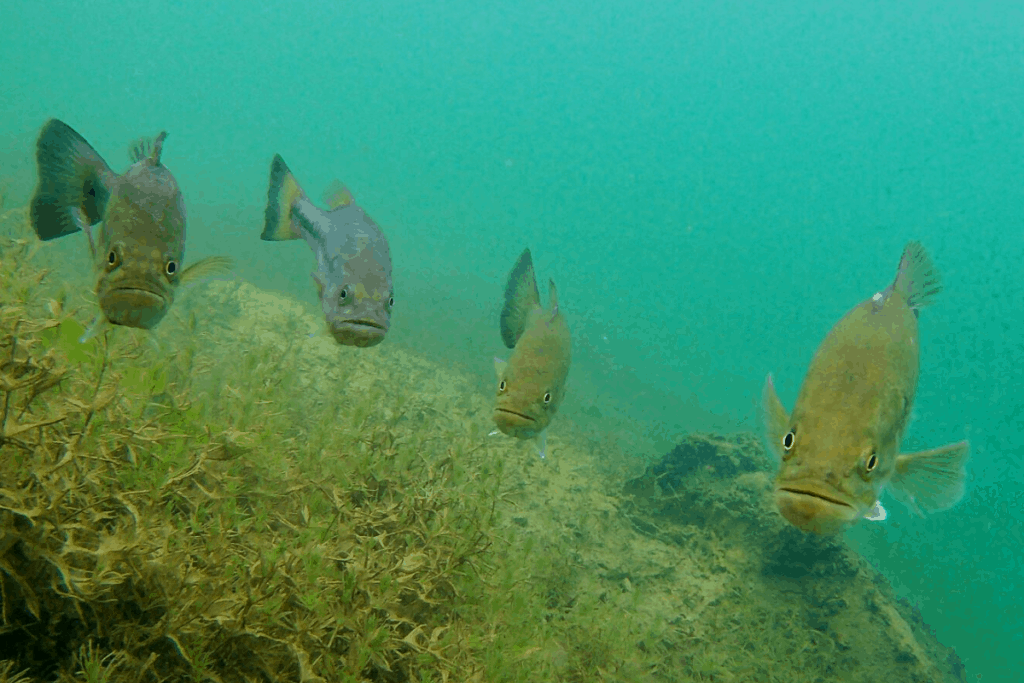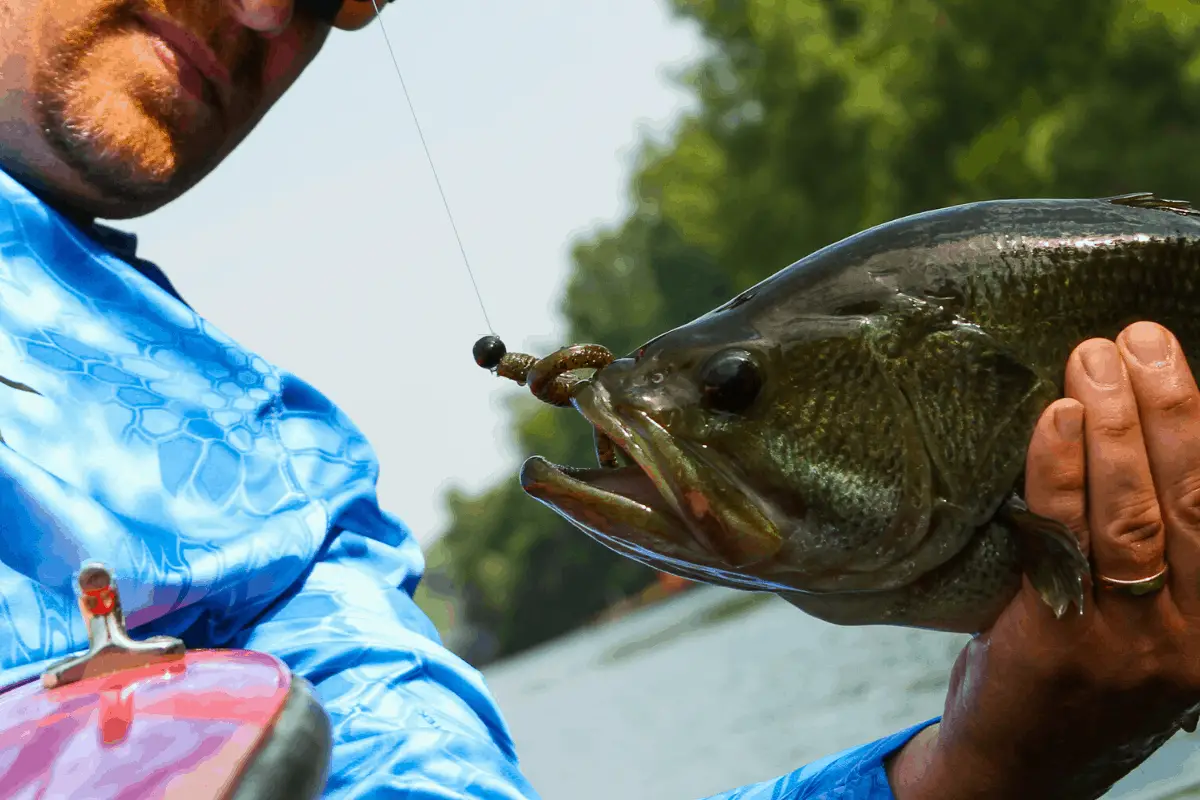The days of seeing lunker bass swimming in the shallows are past us for another year. Summer bass fishing can be challenging, but taking a few factors into consideration can make for some amazing hot-water action.
To key in on bass during the heat of the summer look at water clarity and target the deepest zone you can see into. Focus on what depth the baitfish or bluegills are using. If possible, concentrate on vegetation that oxygenates the water.
In this article, I will go over the main factors to consider when trying to locate and catch bass when the heat is beating down.
Water Clarity Positions Bass
Water clarity is the first factor to consider. If the lake, pond, or river is dirty the bass will be shallow no matter how hot things get.
If there is clarity to the water, the majority of the fish will seek some sort of depth to reach water temperatures that are more comfortable.
How far can you see into the water?
Is it 5ft? 10? Or is it ten inches?
Look for baitfish or prey species activity at those depth levels. On a recent underwater investigation I did on my home lake, the majority of the bluegill were sitting in 10ft of water.
Naturally, this will be a key zone to target for the bass that feed on those sunfish.
Locate Cover or Structure at that Depth
Once you have a general idea of the depth you wish to start looking, locate key structure or cover features at that range.
If the home waters you fish have primarily a rocky makeup, like a highland reservoir, finding ledges and points that drop off into water at that ideal depth will be a high percentage area. This is the part of the water column that will hold the most bass.
Can you find vegetation at the depth level that is showing the most activity?
A weedbed sitting at that key zone will not only hold the prey, but it will concentrate the predators as well.
Also keep an eye out for brushpiles, docks sitting over the ideal depth zone, and any other places that bass can hide while keeping an eye out for an easy meal.
Here is a video below that discusses using the transition line the sun creates to target key depths in clearer bodies of water.
Is there Vegetation? Bass Love It!
Not all lakes, ponds, and rivers have vegetation. If they do, the heat of the summer is when anglers should really focus on targeting the leafy stuff.
Healthy stands of aquatic vegetation not only provide shade and cover, but the oxygen released by the plants is a key component in creating ideal comfort for all sorts of fish – including bass.
There are times when anglers will need to narrow down what type of vegetation seems to be holding the most fish.
One day milfoil may be the preferred plant while a few weeks later the bass may be piled up in hydrilla. Taking the time to notice where you are getting the bites and what types of weedbeds they are coming from can translate to a pattern that may be replicated throughout a body of water.
Find Some Current
If you are blessed to be within driving distance of a nice river – this is the time to fish it.
I love to focus on fishing small rivers when the sun is cooking us here on planet earth. Not only does it eliminate fishing the extreme depths, but the current keeps things more stable and the fish apt to be less finicky from one-day-to-the-next.
If you live on a lake or pond that does not have natural current through it, finding locations that have wind or even waves pushed by boats, can make the bite turn on.
There are many times when fishing natural lakes, anglers can see which direction the aquatic vegetation is leaning. This is a tell-tale sign of movement in the water.
For waters without vegetation, pay close attention to the sticks, the leaves, and other debris. Are they moving? Are they congregating and piling up in a certain area?
Even the slightest amount of natural aquatic movement will draw fish out of slack water areas.

Be Prepared to Find Large Schools of Bass
When the dog-days of summer are on us, the bass have the potential to congregate in large schools. This applies to both largemouth and smallmouth.
While finding a monster school of bass is exciting, the downside means that there is more water with nothing going on.
As anglers, this forces us to change our mindset from catching to searching. Locating a group of bass can take some time. The effort is worth it. When that first fish is caught it may signal that there are many, many, more where that one came from.
Smallmouth bass in the summer like to hunt in packs. My most recent smallmouth trips revealed large schools of hungry bronzebacks following and attacking a lure that was in the mouth of a hooked fish.
Anglers targeting smallies can have a flurry of intense action when one person catches a fish. The other anglers in the boat need to be ready to drop some sort of follow-up lure, like a wacky rig, right into the fray. Be ready – there is a real chance every angler in the boat may hook up at the same time.
One Lure to Locate – Another to Catch
Search baits are important tools during the heat of July, August, and September.
When we know that the fish are likely in groups with lots of empty water between them, fishing slow-moving lures can hinder our efforts.
It is best to fish lures that can cover water efficiently to locate a group of fish.
A search bait does not even need to actually catch a bass, if an angler sees a fish follow the lure back to the boat that may be all the evidence needed to get the bite going.
At that point, it is a good idea to switch over to a more traditional finesse presentation that can work an area thoroughly. Ned Rigs, drop shots, and shaky heads are just some of the presentations that can make quick work of a large school.
For searching, I prefer to use topwaters, crankbaits, Carolina Rigs and a Power Shot rig. In fact, the Power Shot may be my favorite hybrid presentation that still utilizes the effectiveness of a drop shot, yet can be fished much faster.
Here is an article on drop shot fishing that mentions and describes the power shot near the end.
Approach the Day with the Proper Mindset
Bass fishing in the summer can be a mental challenge. It’s tough. The bites will not be quick and often.
It is too easy to give up and put the boat on the trailer. Stick with it.
Search, search, search – then catch.
Knowing that it is only a matter of time to locating that school of fish is a positive influence that can keep us focused.
Trading an hour of thrashing empty water for twenty minutes of potentially catching one on almost every cast is a situation most anglers would be happy with.
The summer is when that type of fishing is a reality and it may lead to the best flurry of action you have ever experienced. Just don’t give up too soon.
Final Thoughts
Start your search by examining the water clarity. Once you have that depth determined, scour your electronics and use those polarized glasses to find some sort of activity at that zone.
These are two major clues in unlocking summer bass fishing.
If you can find current and vegetation, use these to your advantage. Figure out which lures are best for searching and which are going to be best for catching. Keep a positive outlook as you eliminate unproductive water and know that the big school of bass is just one more cast away.
Tight lines. Be safe and don’t forget to encourage someone today. You never know how you may change their life forever.
Isaiah 6:8

